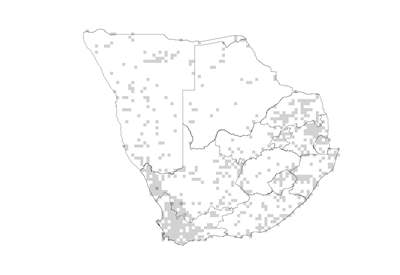 Species distribution and density. Darker squares represent higher density of members of this family. |
Introduction
Colchicum family
A comparatively small family of perennial herbs with tunicated corms or rhizomes and often relatively large flowers.
Distribution
Occurs in tropical and temperate regions of mainly the Old World. Widespread in southern Africa, especially in the Western Cape and in parts of the summer-rainfall region.
Number of genera in the world
ca. 17
Number of species in the world
ca. 170
Number of genera in the Flora of southern Africa region
9
Number of species in the Flora of southern Africa region
104
Well-known southern African genera
Colchicum, Gloriosa, Wurmbea
Growth forms
Erect, sometimes twining herbs arising from corms or rhizomes, sometimes with tuberous roots.
Habitats
Found in arid vegetation, open scrub to forest margins, thicket and damp grassland.
Flagship species
Gloriosa superba (flame lily; vlamlelie [A]; ihlamvu [Z]) is a well-known garden plant in the summer-rainfall areas of South Africa. It is a climbing plant with shiny leaves and spectacular orange and yellow flowers during late summer. Although the plant is extremely poisonous, it is used medicinally. Some of its medicinal and other uses include the treatment of barrenness, pimples, skin eruptions, tick infections and screw-worm on cattle and to kill lice. The brightly coloured seeds are used in necklaces.
Significance of the family
Important as garden subjects (Colchicum, Gloriosa), cut flowers (Gloriosa, Sandersonia) or as greenhouse plants (Sandersonia). Members of this family are known to be used medicinally (Gloriosa) as well as for protection from evil (Sandersonia). Many members of the family contain toxic alkaloids and are poisonous to both livestock and man. They are a source of colchicine, an alkaloid used in plant breeding to create polyploids. (Photo: NC).
Diagnostic characters
Geophytes with starch-rich corms or rhizomes. Leaves alternate, sessile, sheathing at the base , sometimes on long trailing stems . Flowers borne in terminal racemes or cymes, mostly regular with perianth in 2 whorls of 3 tepals each . Stamens in 2 whorls of 3 each . Ovary superior � with 3 locules; styles 3, sometimes joined at the base. Fruit a dry, or somewhat fleshy, septicidal or loculicidal capsule .
Did you know?
The flowers of Colchicum species produce a reasonable amount of nectar and are pollinated by rodents.